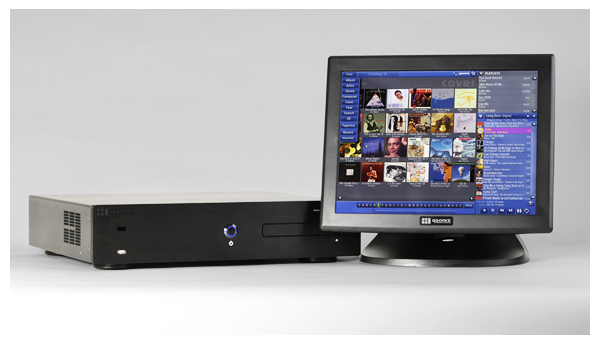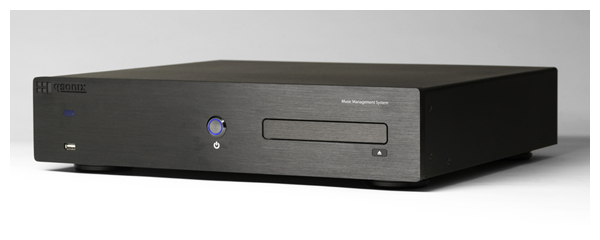The QSonix Q205

Much changed in the 18 months since we reviewed the QSonix Q105 music server. It was a highly capable device, but as is typical with most first-generation music servers, R&D wasn’t spent on the audio section of the product. In this respect, QSonix was no more guilty than any other manufacturer.
But things move fast in computer audio. And just like its main competitor, Sooloos (which became part of Meridian about 18 months ago), QSonix found an equally capable partner in Wadia, a longtime pioneer in the world of high-performance digital audio. Wadia has since contributed a purpose-built digital output board that not only offers 24/192 output, but does so via USB, SPDIF, Toslink and Balanced EBU connections, allowing the new Q205 to claim far better sound than the original as well as sound on par with Wadia’s best CD players. Thanks to these enhancements, the Q205’s audio performance is commensurate with its interface.
(QSonix remains committed to legacy users. Those owning Q105 systems can upgrade their software to the current version, which allows iPad access. Anyone desiring the digital output board is afforded a liberal trade-in towards a Q205. Since everything is nearly completely new inside the Q205, simple upgrades are not possible.)
Like the Sooloos, the QSonix has always showcased a highly intuitive interface—the key to an excellent music server. Much like comparing Apple’s iPad to the Android tablet, both devices do things their own way. But they both offer the most information and make use of a touch screen that’s laden with album art, meaning you can access your music the way you remember it—by the cover.
The Q205 sells for $7,450 to $8,250, depending on whether you purchase the 1TB or 2TB version. Or you can buy it without the touch screen for about $1,200 less and control the server via an iPad. It stores 2700 CDs in lossless format (FLAC or WMA), or 1500 uncompressed WAV files per terabyte. Countless arguments abound on the virtue of lossless vs. WAV, but everyone save those with canine hearing will be hard-pressed to hear the difference between FLAC and WAV.
Presently, the Q205 handles a maximum of 2TB, which means 5400 CDs will be the limit, assuming all your files are in 16/44 format. High-resolution audio files are two-to-four times the size of CD-quality files, so take that into account if you prefer hi-res music. However, Weaver hinted that as soon as QSonix can finish certification of a few enterprise-level 3TB hard drives, the latter will be an option for those with bigger-than-average music collections. He claims QSonix “insists on the enterprise drives because they have much greater durability than the standard drive you buy at a computer store.”
Test Environment
We put the Q205 through its paces with a handful of great DACs: the dCS Debussy, Naim DAC, and the Wadia 381i that we have been using for some time. The QSonix performed equally well with all of them. Sound quality wasn’t diminished with either the spdif, abs/ebu, or USB outputs. However, the optical (Toslink) sported somewhat lower fidelity.
Because the Wadia 381i forms such a synergistic match with the Audio Research REF 150, sans preamplifier, I did the bulk of listening with this configuration. For those that don’t require an analog input, this combo makes for an excellent system, as Wadia’s patented Digital Volume Control eliminates the need for a preamplifier. A pair of B&W 802 Diamond speakers, with Cardas Clear interconnects and speaker cable, rounded out the system. An AudioQuest Diamond 110-ohm digital cable linked the Q205 and the 381i.
Functionality
Setting up the Q205 is painless, and only requires two cables between the touch-screen monitor and server, a cable between the Q205 and your DAC of choice, and power. Both the monitor and Q205 use wall-wart power supplies— 12-volt for the Q205 and 9-volt for the monitor. After the individual pieces are connected, the Q205 needs to be connected to your Ethernet network via a standard RJ-45 cable.
A simple, menu-driven group of set-up screens will have you importing your CDs in minutes. This is when you choose the quality level for ripped files: uncompressed WAV, lossless WMA, or MP3. While the Q205 will rip files as WAV, it will not allow you to import WAV files that you previously ripped elsewhere. The current version of the software supports virtually all popular audio file formats: MP3, WMA, Lossless, FLAC, WAV, AIFF, M4A and Apple Lossless, including 24 bit versions. Files can be easily imported via the Ethernet network or directly through one of the USB ports using an external hard drive or thumb drive. The system also features advanced media recognition capabilities that will automatically retrieve album art and metadata including composer information, album reviews and playlist suggestions.
Once setup is complete and music imported, it is not necessary to keep the Q205 tethered to your Ethernet network. Even if disconnected, the Q205 can still import CDs without metadata, and upon reconnection, you can update your library at a later date. Should you be inclined for a mix disc, or one of your original CDs becomes irreparably damaged, the Q205 lets you burn a CDR from the music in your collection—another handy feature the competition lacks.

User Environment
Once loaded, your music can be viewed in album art or library mode, with all data accessible via a touch screen of your choice. As with the setup, if you do not want to use a touch screen or iPad, a regular computer monitor and mouse will work, albeit at the sacrifice of some slickness.
The QSonix operates via playlists that you create and, if you so desire, save. The playlist appears on the right third of the monitor; the rest of the data occupies the left two-thirds of the screen. Merely drag tracks or whole albums over to the playlist, and the music begins.
The key to QSonix software is spontaneity. No matter how much music you’ve selected, a change of mood or direction requires no more than a touch. You can insert a track, tracks, or an entire album inside a current playlist or start fresh. If you’re feeling indecisive, random play is always a great option.
Cooler Than Cool
Everything I’ve mentioned makes the Q205 an amazing music server. But the QSonix iPad app puts it at the head of the pack—and by a considerable margin. Unlike all of the other major servers, which merely provide an awkward iTunes-like interface, QSonix ports the entire app to your iPad.
Now you can sit on your couch with a gigantic Wall-e beverage in hand and surf your music collection via album art. This is the way to roll, and once you get used to it, you’ll never want to go back. The iPad is incredibly handy when you have a group of friends over to listen. Just pass the pad around and let everyone have a shot at being DJ. Weaver’s market research concurred with my own unofficial findings: Most people remember music by the album art, and many do not want a gigantic computer screen in their listening room. For anyone that does, a QSonix 15”, 17”, or 19” touch screen can be put on a coffee table or wall-mounted.
Settings preferences and media loading are the only parts of the QSonix interface missing from the iPad. You will either need that touch screen or a standard flat-screen monitor and PC mouse. At first, this seemed inconvenient, but in retrospect, it’s probably not a great idea to allow drunken party guests to have the ability to erase your music library.
Liberation from a tethered monitor also allows for the freedom of either putting the Q205 in another room (so it is out of sight) or simply mounting it in your rack. Where the Q105 made just enough noise that keeping it in a closet proved a good idea, the current model is so silent that you will not hear the fans even when sitting within close proximity.
Those wanting to use the Q205 in a multiple-system capacity can utilize the direct digital outputs in one system and the USB output as a separate zone. Both zones can be accessed via iPad or computer, and can simultaneously stream different music.
Fun, Fun, Fun
Perusing someone else’s music server is somewhat like sneaking a peek at your kid sister’s secret diary. So I couldn’t resist pushing play on “I Am a Girl Like You” from Barbie as the Princess and the Pauper. I’ll take Barbie over Patricia Barber any day, but one song is enough. Kidding aside, Barbie never sounded better, and it was easy to discern the perky track’s multiple overdubs and vocal processing.
Serious listening began in earnest with some recent 24/96 rips from my DVD-A collection, starting with Emerson, Lake and Palmer’s “Still You Turn Me On.” The progress the Q205 made over its predecessor became instantly evident. The low bass had plenty of authority and low-level detail. Indeed, this server has gone from middle of the road to the front of the pack. Another quick comparison with MoFi’s Gold CD of Beck’s Sea Change revealed the same parity—the ripped file sounded identical to the original, if not a little bit more liquid in presentation. After hours of listening, it was unnecessary to go back to the CD tray for playback; the Q205 is that good. Digging deeper into the QSonix collection, I found a copy of Frank Zappa’s Trance Fusion and could not resist playing my favorite cut, “Ask Dr. Stupid.” See why a music server is so much fun?
Moreover, hi-res files proved easy to integrate into the Q205. No glitches with playlists containing tracks of varying sampling rates, and the QSonix software allows effortless and artifact-free switching, another plus.
Tweaks
Jay Leno once said car guys are either “wrench turners or check writers.” The same applies to computer audio disciples. Because the Q205 takes care of most everything with its closed architecture, there isn’t much to tweak or change. But I suggest two things: A good digital cable to go between it and your DAC, and a high-performance battery power supply from Red Wine Audio. One of the latter’s Black Lightning supplies will take the Q205 completely off the grid and eliminate RFI caused by wall warts. Plugging the Q205 into a Black Lightning noticeably lowers the grain and takes the already high-quality playback a step closer to perfection.
Sound Quality, Functionality, and Portability
While I’m someone who always considered a music server a convenience component first and an audiophile component second, the QSonix Q205 changed my thinking. It not only raised the bar for the level at which a music server can perform, the device leaves its peers the dust. Its only limitation? The 2TB storage limit, which should be an issue for just a very small percentage of users requiring storage of greater than 4000 – 5000 CD’s. We will be installing a QSonix system in our editor Bob Gendron’s system shortly to see how it fares long term. Stay tuned.

QSonix Q205 Music Server
MSRP: $6,600 – $8,200 (depending on configuration)
Peripherals
Preamplifier Audio Research REF 5, Wadia 381i
Power Amplifier Audio Research REF 150
DAC Wadia 381i
Speakers B&W 802 Diamond
Cable Cardas Clear, AudioQuest Diamond (digital cable)
Power Running Springs Maxim PLC



